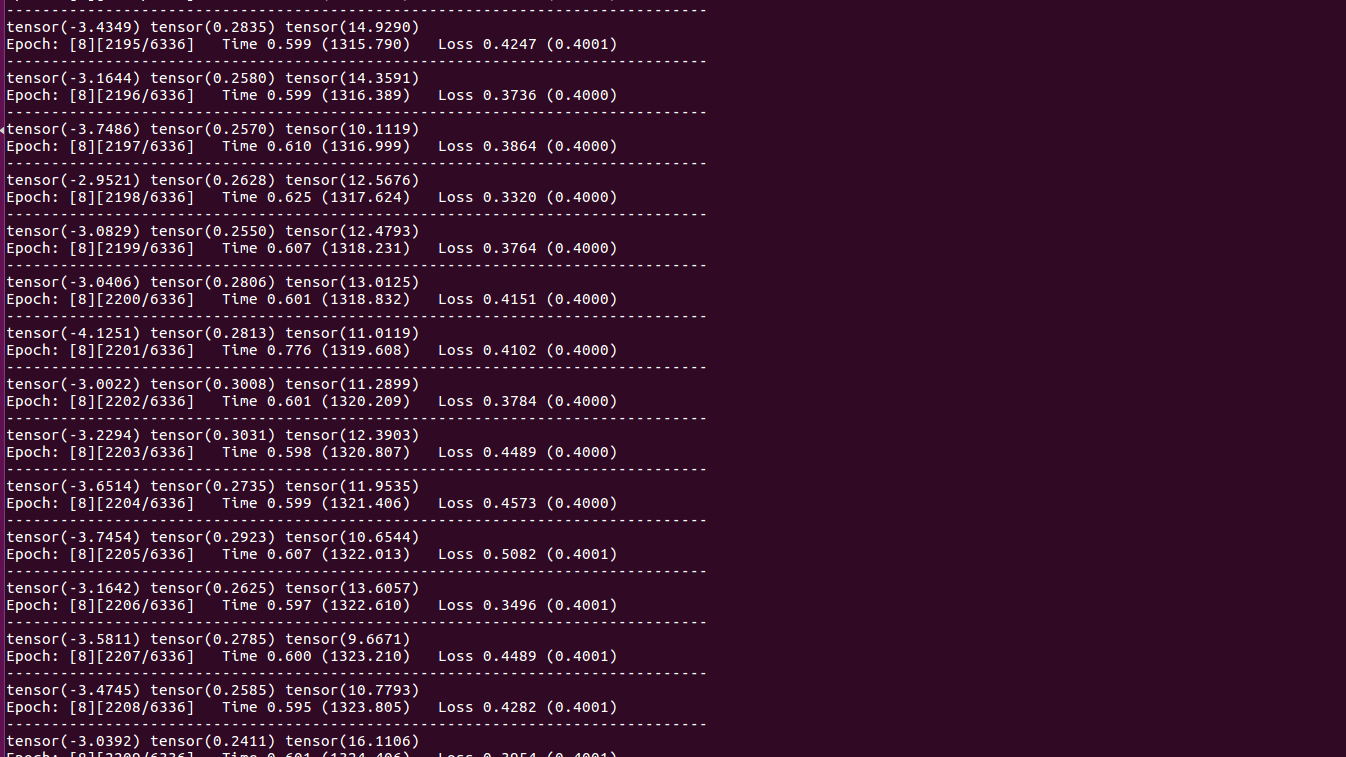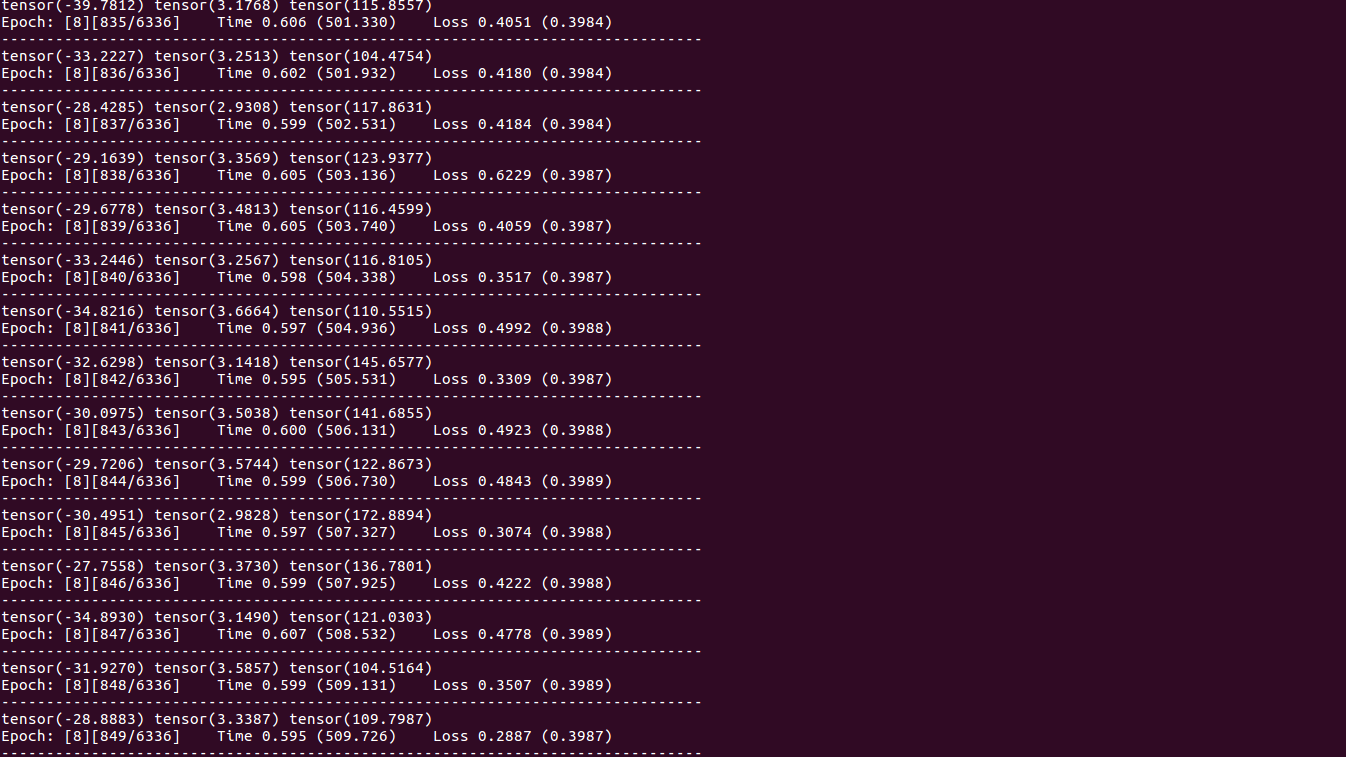Comments (14)
Hi! Please see: https://gist.github.com/dvdhfnr/732c26b61a0e63a0abc8a5d769dbebd0
Hi this link is failed, could you share a new one
Thanks.
from midas.
Hi!
Please see: https://gist.github.com/dvdhfnr/732c26b61a0e63a0abc8a5d769dbebd0
from midas.
@dvdhfnr I implemented the loss by myself. I found that the range of prediction is unstable. It can be -3 -- 8, -10 -- 30, -200 -- 1000, in differernt training attempts. I wonder if your met the problem when you trained the network. Thank you very much.
from midas.
No, I did not met this problem. Did you scale/shift the target depths to [0, 10], as described in the paper?
from midas.
@dvdhfnr I train my model on NYUDepthV2, and scale/shift the depth value by
mask = target > 0
target[mask] = (target[mask] - target[mask].min()) / (target[mask].max() - target[mask].min()) * 9 + 1
target[mask] = 10. / target[mask]
target[~mask] = 0.
How did you scale/shift the depth map?
from midas.
To be more precise:
"For all datasets, we shift and scale the ground-truth inverse depth to the range [0, 10]."
from midas.
I test the provided midas_loss. It also leads to unstable output range. The output range is influenced by the initial weights.
I trained the network with different initial weights, and got the following results, in which the three numbers are the min, mean and max of prediction:


Maybe there should be additional constraints on the prediction to restrict the output range.
Finally, I am looking forward to the scripts that are used to produce the data set.
from midas.
The predictions resemble the target inverse depths up to a scale and shift.
from midas.
As @dvdhfnr mentioned: This is by construction, as the value of the loss is independent of the output scale. Thus the ranges are dependent on the initialization. If you need a fixed scale range, you could try to add a (scaled) sigmoid to the output activations. However, this might change training behavior and you likely need a sensible initialization.
from midas.
To be more precise: "For all datasets, we shift and scale the ground-truth inverse depth to the range [0, 10]."
@dvdhfnr Hi, I found the normalization range is [0, 1] in original paper, so which range is correct?
thx
from midas.
For the latest version of the paper we used the range [0, 1] (https://arxiv.org/pdf/1907.01341v3.pdf, Page 7).
#2 (comment) was referring to an earlier version (https://arxiv.org/pdf/1907.01341v1.pdf, Page 6).
from midas.
@dvdhfnr Hi, did you use this loss function for MiDaS v3.0 as well?
from midas.
@dvdhfnr @ranftlr Hi,
I want to know how did you rescale the ground truths depth to range [0,1].
As my understanding, the following steps are done:
- Get the ground truth inverse depth
- Normalize like this inverse_depth_normalization = (inverse_depth- inverse_depth.min()) / (inverse_depth.max() - inverse_depth.min())
Does my understanding right? if not, could you please tell us how do you do "For all datasets, we shift and scale the ground-truth inverse depth to the range [0, 1]."?
Thx.
from midas.
@Twilight89
Same problem. I think the author will never reply. Do you have any conclusion? Or do you implement the training process?
from midas.
Related Issues (20)
- module 'cv2.cv2' has no attribute 'COLORMAP_INFERNO'
- What is the loss function?
- Copy of MiDaS model made with `copy.deepcopy` does not work. HOT 1
- swin2_tiny failed to run forward(): RuntimeError: unflatten: Provided sizes [64, 64] don't multiply up to the size of dim 2 (64) in the input tensor. HOT 1
- [question] Any suggestions on normalizing the outputs better? HOT 9
- Error Loading Pre-trained Weights: Size Mismatch in DPTDepthModel when trying to run for first time. HOT 7
- System crash when loading DPT_Hybrid
- PyTorch Pipeline Broken HOT 2
- gibberish output? HOT 4
- DPT 3.1 models are now available in the Transformers library HOT 1
- Question about COCO dataset HOT 1
- DEPTH VALUE OF THE EACH PIXEL HOT 12
- iOS Demo app is slowing down over time, and the first inference seems much slower HOT 2
- Converted MiDaS 2.1 TFLite model get wrong result on Mobile HOT 5
- MiDaS 2.1 TFLite fp16 with Core ML Delegate gets wrong results
- Cant find pretrained model HOT 1
- Imp. (Improvement) description in the documents
- Exact distance of image HOT 7
- Can't see output...
- New ‘ModuleNotFoundError’ HOT 1
Recommend Projects
-
 React
React
A declarative, efficient, and flexible JavaScript library for building user interfaces.
-
Vue.js
🖖 Vue.js is a progressive, incrementally-adoptable JavaScript framework for building UI on the web.
-
 Typescript
Typescript
TypeScript is a superset of JavaScript that compiles to clean JavaScript output.
-
TensorFlow
An Open Source Machine Learning Framework for Everyone
-
Django
The Web framework for perfectionists with deadlines.
-
Laravel
A PHP framework for web artisans
-
D3
Bring data to life with SVG, Canvas and HTML. 📊📈🎉
-
Recommend Topics
-
javascript
JavaScript (JS) is a lightweight interpreted programming language with first-class functions.
-
web
Some thing interesting about web. New door for the world.
-
server
A server is a program made to process requests and deliver data to clients.
-
Machine learning
Machine learning is a way of modeling and interpreting data that allows a piece of software to respond intelligently.
-
Visualization
Some thing interesting about visualization, use data art
-
Game
Some thing interesting about game, make everyone happy.
Recommend Org
-
Facebook
We are working to build community through open source technology. NB: members must have two-factor auth.
-
Microsoft
Open source projects and samples from Microsoft.
-
Google
Google ❤️ Open Source for everyone.
-
Alibaba
Alibaba Open Source for everyone
-
D3
Data-Driven Documents codes.
-
Tencent
China tencent open source team.


from midas.